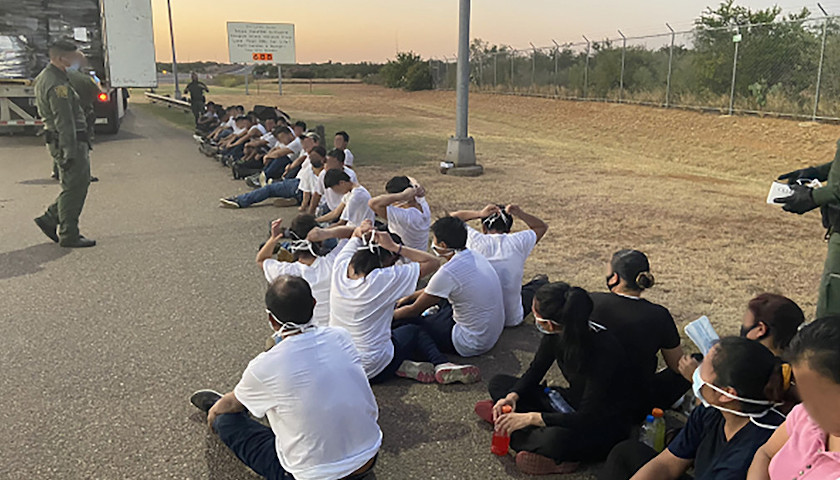by Bethany Blankley
Among the more than 8.6 million people who’ve illegally entered the U.S., at least nearly 1.6 million are “gotaways.”
Gotaways is the official term used by Border Patrol agents to describe foreign nationals who illegally enter the U.S. between ports of entry and don’t return to Mexico or Canada.
They don’t file asylum or other immigration-related claims – they intentionally illegally enter to avoid being caught. Many have criminal records. They often run when they are pursued by Border Patrol agents or others in law enforcement, authorities tell The Center Square. They do not want to be caught.
The majority of gotaways are single, military age men. However, they also include women and children, many who are smuggled, law enforcement officers say.
Gotaway data represents the best guess of agents who report the number of people they believe to be gotaways, agents have explained to The Center Square. Agents report gotaways based on images of people caught on cameras set up by Border Patrol, ranchers or private property owners. Agents also report gotaways after they “cut sign,” a term agents use to track people in the brush. They look for shoe or boot marks or areas wiped clean to hide them, broken limbs of trees or bushes, garbage and clothes left on the ground, among other signs to determine how many people might have come through. Based on this and other factors, agents report who and how many they believe are “known, reported gotaways.”
The data is considered a “best estimate,” agents have explained to The Center Square. It doesn’t adequately portray how many foreign nationals illegally enter because they simply don’t know how many there are. The data excludes the unknown number coming through who are undetected, and therefore, aren’t reported.
The Center Square has been reporting preliminary gotaway data every month received from a Border Patrol agent who accesses an internal U.S. Border Patrol database. The preliminary data excludes Office of Field Operation data. The agent provides the data on condition of anonymity for fear of reprisal. Because the data doesn’t include OFO data, when U.S. Customs and Border Protection releases its official apprehension data, usually two weeks after The Center Square reports preliminary data, the total is always higher because it includes the OFO data. CBP does not publicly report gotaway data.
Even the preliminary data, though, is an estimate because it goes through a “reconciliation” process, meaning it’s changed by a sector chief, a Border Patrol agent told The Center Square. After agents report their findings, for a range of reasons, sector chiefs change them, and in some Texas sectors, the agent said, gotaway numbers don’t make sense. Some sectors are reporting significantly lower gotaway data than they did previously but they still have a high volume of foot traffic.
Former Border Patrol Chief Raul Ortiz acknowledged the discrepancy with how gotaway data is reported when he testified before Congress, saying gotaway data is underreported by between 10% to 20%.
When adding 6,547,514 official CBP total national apprehensions and confirmed 1,454,805 gotaways from January 2021 through April 2023, previously reported by The Center Square, with additional three months of data the numbers are the highest they’ve been in U.S. history.
In May, more than 240,000 illegal border crossers were reported, including at least 60,327 gotaways. In June, at least 175,000 illegal border crossers were reported, including 50,000 gotaways. In July, at least 200,500 illegal border crossers were reported including 27,000 gotaways.
Combined, illegal border crossers reported since January 2021 total at least 8,617,819, greater than the estimated individual populations of 38 U.S. states. They total more than all U.S. cities with the exception of New York City, all U.S. counties with the exception of Los Angeles County, and the populations of over 120 countries.
In fiscal 2021, there were at least 308,655 known, reported gotaways. In fiscal 2022, 606,150; in fiscal 2023 at least 540,000 as of April, The Center Square has previously reported. Adding May, June and July numbers, they total at least 677,327.
Combined, known, reported gotaways total at least 1,592,132, greater than the individual populations of 11 states.
Below is a glimpse into what gotaways look like who were caught on camera primarily in Terrell County in the Big Bend Sector of Texas.
Border Patrol agents, law enforcement officers, Homeland Security – the agency tasked with defending the homeland – have no idea who or where these gotaways are. They also have no idea how many came through who weren’t captured on camera.
The Border Report: #Gotaways caught on camera primarily in Terrell County in Big Bend Sector of Texas. Border Patrol agents, law enforcement, Homeland Security—tasked w defending the homeland—have no idea who or where they are. Nearly 1.6 million, => ind populations of 11 states. pic.twitter.com/PHnXFWrOFR
— Bethany Blankley (@BethanyBlankley) August 24, 2023
– – –
Bethany Blankley is a contributor to The Center Square. To learn more, follow The Border Report with Bethany Blankley on Facebook and X.
Photo “Illegal Immigrants” by Chief Jason Owens.




